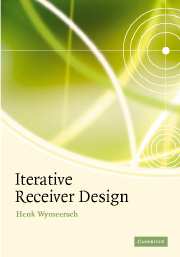Book contents
- Frontmatter
- Contents
- Preface
- Abbreviations
- Notations
- List of algorithms
- 1 Introduction
- 2 Digital communication
- 3 Estimation theory and Monte Carlo techniques
- 4 Factor graphs and the sum–product algorithm
- 5 Statistical inference using factor graphs
- 6 State-space models
- 7 Factor graphs in digital communication
- 8 Decoding
- 9 Demapping
- 10 Equalization–general formulation
- 11 Equalization: single-user, single-antenna communication
- 12 Equalization: multi-antenna communication
- 13 Equalization: multi-user communication
- 14 Synchronization and channel estimation
- 15 Appendices
- References
- Index
2 - Digital communication
Published online by Cambridge University Press: 08 January 2010
- Frontmatter
- Contents
- Preface
- Abbreviations
- Notations
- List of algorithms
- 1 Introduction
- 2 Digital communication
- 3 Estimation theory and Monte Carlo techniques
- 4 Factor graphs and the sum–product algorithm
- 5 Statistical inference using factor graphs
- 6 State-space models
- 7 Factor graphs in digital communication
- 8 Decoding
- 9 Demapping
- 10 Equalization–general formulation
- 11 Equalization: single-user, single-antenna communication
- 12 Equalization: multi-antenna communication
- 13 Equalization: multi-user communication
- 14 Synchronization and channel estimation
- 15 Appendices
- References
- Index
Summary
Introduction
As with any good story, it is best to start at the very beginning. Digital communication deals with the transmission of binary information (obtained as the output of a source encoder) from a transmitter to a receiver. The transmitter converts the binary information to an analog waveform and sends this waveform over a physical medium, such as a wire or open space, which we will call the channel. As we shall see, the channel modifies the waveform in several ways. At the receiver, this modified waveform is further corrupted due to thermal noise. Not only does the receiver have to recover the original binary information, but also it must deal with channel effects, thermal noise, and synchronization issues. All in all, the receiver has the bad end of the deal in digital communications. For this reason, this book deals mainly with receiver design, and only to a very small extent with the transmitter.
In this chapter we will describe several digital transmission schemes, detailing how binary information is converted into a waveform at the transmitter side, and how a corrupted version of this waveform arrives at the receiver side. Right now, our focus is not on how the corresponding receivers should be designed. Since there is a myriad of digital transmission schemes, we are obliged to limit ourselves to some of the most important ones.
- Type
- Chapter
- Information
- Iterative Receiver Design , pp. 5 - 18Publisher: Cambridge University PressPrint publication year: 2007



